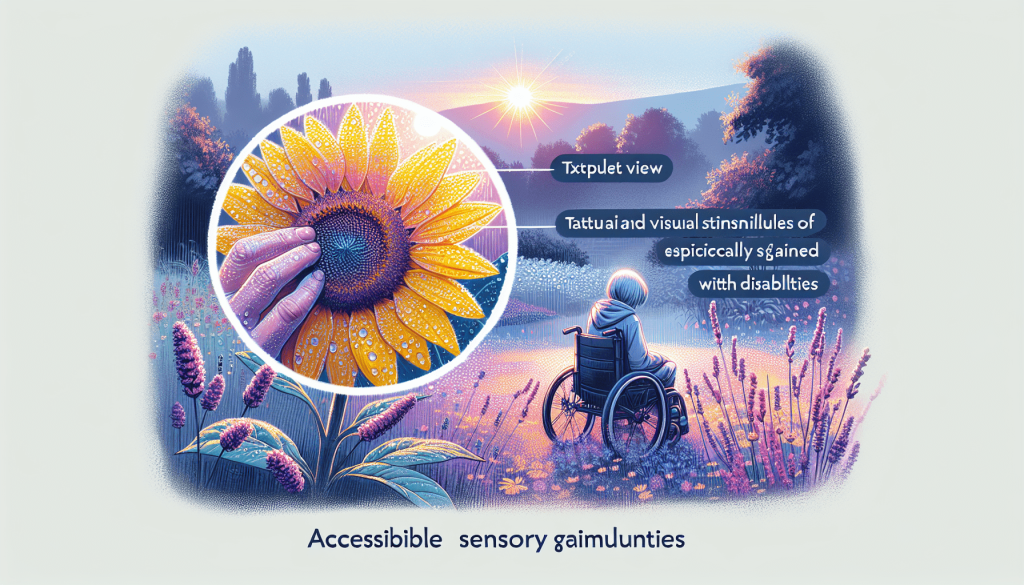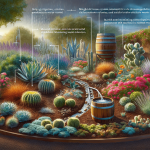This post may contain affiliate links. As an Amazon Associate, we may earn commissions from qualifying purchases.
Creating a sensory garden for individuals with disabilities is a wonderfully rewarding endeavor that not only beautifies your space but also provides a therapeutic, engaging environment for those who need it most. Imagine a garden where the vibrant colors, fragrant smells, and tactile plants come together to form a sanctuary of sensory experiences. In this guide, you’ll learn how to thoughtfully design and incorporate elements like raised garden beds, aromatic herbs, and water features to create a nurturing haven that is accessible and enjoyable for everyone. Buckle up for a journey that promises to transform your garden into a paradise of inclusivity and sensory delight! Have you ever wondered how you can create a sensory garden for individuals with disabilities? Creating an inclusive sensory garden involves much more than just planting some flowers; it’s about designing an accessible, engaging space that stimulates all the senses. Everyone, regardless of their abilities, can benefit from the therapeutic and calming effects that a sensory garden offers.
What is a Sensory Garden?
A sensory garden is designed to stimulate your senses (sight, touch, hearing, smell, and taste) in ways that traditional gardens often do not. For individuals with disabilities, these gardens can provide a multitude of benefits such as enhanced relaxation, concentration, and improved mood.
Benefits of a Sensory Garden
Your sensory garden will provide numerous advantages:
- Emotional Well-being: Calming environment to reduce stress and anxiety.
- Physical Activity: Opportunities for gentle exercise.
- Mental Stimulation: Engages brain function through various sensory inputs.
- Social Interaction: A welcoming place for social activities.
Planning Your Sensory Garden
Before you start digging holes, a bit of planning can go a long way in ensuring that your sensory garden meets the needs of its users. Let’s break it down step-by-step.
Assess the space
First, look at your available space. How much room do you have? Take note of the sunlight, shade, and soil types, as these factors will influence your plant choices.
Identify the Users
Understand who will be using the garden. Are they children, adults, or seniors? Also, determine the types of disabilities these individuals have, as this will affect the garden’s design.
Set Your Objectives
What do you hope to achieve with your sensory garden? Whether it’s relaxation, education, or therapy, setting clear goals will guide your design choices.

Designing the Sensory Garden
Accessibility
The garden should be easily accessible to everyone, regardless of mobility levels. Consider these points:
| Feature | Description |
|---|---|
| Pathways | Smooth, wide paths that support wheelchairs and walkers |
| Raised Beds | Easier reach for people in wheelchairs or those who have trouble bending |
Sensory Zones
Divide your garden into zones that individually focus on stimulating different senses.
Sight
Bright flowers, colorful garden decor, and strategically placed lighting can create a visually engaging area.
Touch
Plants with various textures can be fascinating to touch. Think lamb’s ears, ornamental grasses, and rough barks.
Sound
Water features, wind chimes, and even birds can add lovely sounds to your garden.
Smell
Fragrant plants like lavender, mint, and roses will provide a delightful olfactory experience.
Taste
Include edible plants such as strawberries, herbs, or vegetables that can be safely tasted.
Safety Considerations
Safety is paramount in your sensory garden. Make sure all pathways are non-slip, and avoid plants that are toxic if touched or ingested.
Choosing Plants
Selecting plants for your sensory garden is both an art and a science. You’ll want a variety of plants to engage all the senses. Here are some suggestions:
For Sight
| Plant | Description |
|---|---|
| Marigolds | Bright, cheerful flowers |
| Coleus | Varied and vibrant foliage |
| Sunflowers | Tall and striking with large blooms |
For Touch
| Plant | Description |
|---|---|
| Lamb’s Ears | Soft, fuzzy leaves |
| Ornamental Grasses | Different textures and movement |
| Bottlebrush Plant | Unique bristle-like flowers |
For Sound
| Feature | Description |
|---|---|
| Bamboo | Creates soothing rustling sounds |
| Wind Chimes | Add auditory stimulation |
| Water Fountain | Provides a calming, continuous sound |
For Smell
| Plant | Description |
|---|---|
| Lavender | Relaxing and fragrant flowers |
| Basil | Strong, spicy-smelling herb |
| Jasmine | Sweet-smelling, night-blooming flowers |
For Taste
| Plant | Description |
|---|---|
| Strawberries | Sweet and easy to grow |
| Basil | Can be used fresh or dried in cooking |
| Cherry Tomatoes | Bite-sized and delicious |

Engaging All Ages and Abilities
Multi-sensory Activities
Incorporate activities that engage different senses simultaneously. Here are some ideas:
| Activity | Description |
|---|---|
| Sensory Herb Walk | Guided walks with hands-on herb interaction |
| Nature Art | Creating art from natural elements |
| Interactive Water Features | Allowing visitors to touch and play with water |
Adaptive Tools
Ensure that tools and equipment are designed to be used by individuals with various disabilities:
| Tool | Description |
|---|---|
| Easy-grip Tools | Tools with larger handles for easier grip |
| Lightweight Watering Cans | Easier to carry and use |
Maintenance and Sustainability
Regular upkeep is essential to keep your garden thriving and accessible.
Volunteer Programs
Get the community involved. Volunteers can help with maintaining the garden and using it as an educational tool can foster greater community integration.
Sustainable Practices
Use eco-friendly gardening practices, like composting and rainwater collection, to make your garden sustainable.
| Practice | Description |
|---|---|
| Composting | Reduces waste and enriches soil |
| Rainwater Harvesting | Conserves water resources |
Evaluating the Success of Your Sensory Garden
User Feedback
Regularly solicit feedback from the garden’s users to make necessary adjustments.
Achieving Objectives
Reevaluate your original goals and see if your garden is meeting them. If necessary, make changes to better achieve your objectives.
Conclusion
Creating a sensory garden for individuals with disabilities is a rewarding endeavor that enhances quality of life through nature. By carefully planning and designing an accessible, inclusive space, you can provide endless benefits to your community. Happy gardening!








